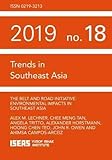The Belt and Road Initiative : Environmental Impacts in Southeast Asia / Tan Tan, Alex M. Lechner, Angela Tritto, Ahimsa Campos-Arceiz, Alexander Horstmann, Hoong Chen Teo, Owen Owen.
Material type: TextPublisher: Singapore : ISEAS Publishing, [2020]Copyright date: ©2019Description: 1 online resource (40 p.)Content type:
TextPublisher: Singapore : ISEAS Publishing, [2020]Copyright date: ©2019Description: 1 online resource (40 p.)Content type: - 9789814881425
- 9789814881432
- online - DeGruyter
- Issued also in print.
| Item type | Current library | Call number | URL | Status | Notes | Barcode | |
|---|---|---|---|---|---|---|---|
 eBook
eBook
|
Biblioteca "Angelicum" Pont. Univ. S.Tommaso d'Aquino Nuvola online | online - DeGruyter (Browse shelf(Opens below)) | Online access | Not for loan (Accesso limitato) | Accesso per gli utenti autorizzati / Access for authorized users | (dgr)9789814881432 |
Frontmatter -- FOREWORD -- The Belt and Road Initiative: Environmental Impacts in Southeast Asia -- REFERENCES
restricted access online access with authorization star
http://purl.org/coar/access_right/c_16ec
China's Belt and Road Initiative (BRI) is expected to be the largest infrastructure development scheme of the twenty-first century. There is escalating concern over BRI's potential environmental impacts in Southeast Asia, a global biodiversity hotspot and a focus area of BRI development. Case studies of Indonesia, Myanmar, Lao PDR and Malaysia show that the success of BRI in bringing about sustainable growth and opportunities depends on the Chinese government and financiers, as well as the agencies and governments involved when BRI investments take place. The adoption of best environmental practices is critical in ensuring that growth is sustainable and that bad environmental practices are not locked in for decades to come.
Issued also in print.
Mode of access: Internet via World Wide Web.
In English.
Description based on online resource; title from PDF title page (publisher's Web site, viewed 24. Aug 2021)


